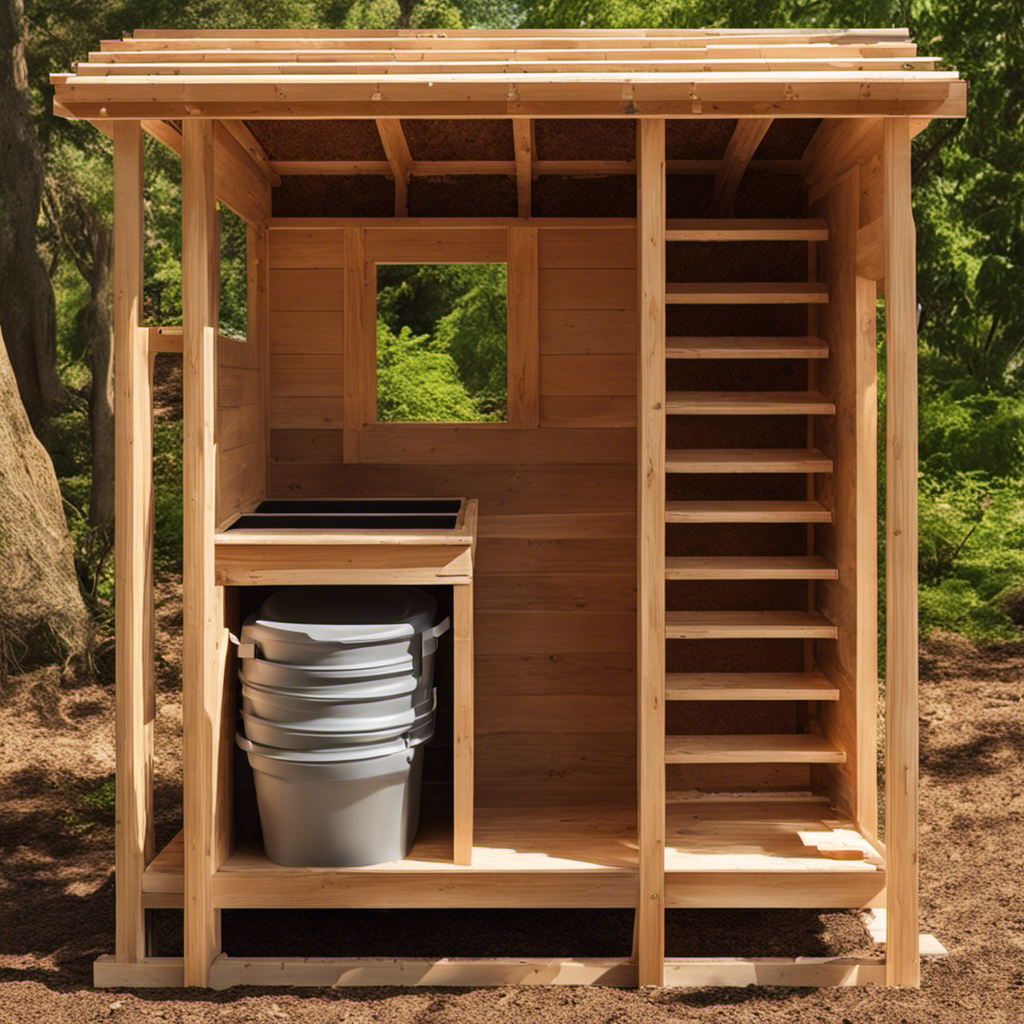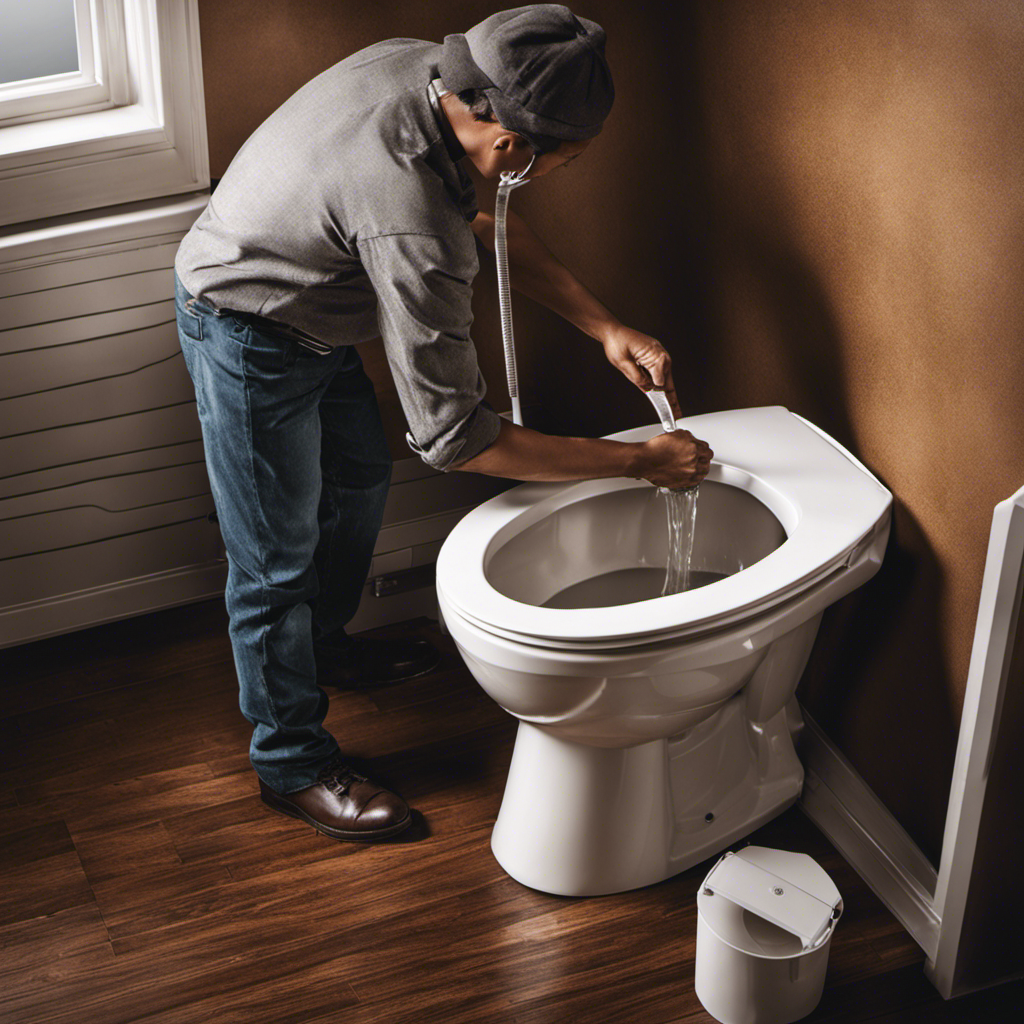Hey there! Ready to take your sustainability efforts to the next level? Look no further, because we’ve got the ultimate guide on how to build your very own composting toilet. Yup, you heard that right – a toilet that turns waste into nutrient-rich compost.
Say goodbye to water waste and hello to a greener future. In this article, we’ll walk you through every step, from selecting the perfect location to troubleshooting any issues.
Let’s get started on this eco-friendly adventure!
Key Takeaways
- Consider available space and number of users when choosing a design.
- Composting toilets conserve water and convert waste into compost.
- Insulate the chamber to maintain the ideal temperature range.
- Install a vent pipe to allow odors to escape and promote airflow.
Selecting the Right Location
You’ll need to find a suitable spot for your composting toilet. When choosing the right design, consider the space available and the number of people who will be using it. A compact design may be ideal for small spaces, while larger designs with separate compartments for urine and solid waste may be more suitable for larger households.
Additionally, managing odor control is an essential aspect of composting toilets. Look for designs that include ventilation systems or fans to promote airflow and prevent odors from building up. Some models also incorporate carbon filters or natural additives like sawdust or coconut coir to further reduce smells.
Remember to place your composting toilet in a well-ventilated area, away from living spaces, and ensure proper maintenance and regular emptying to keep odors at bay.
Gathering the Necessary Materials
Once you’ve gathered all the necessary materials, it’s time to start assembling your composting toilet. Before you begin, it’s important to choose the right design for your needs. Consider the following options:
- Clivus Multrum: This design uses a continuous composting process and requires minimal maintenance.
- Self-contained: These toilets are compact and ideal for small spaces like tiny homes or RVs.
- Batch composting: This design allows for a larger capacity and faster composting process.
Building your own composting toilet offers several benefits. Firstly, it helps to conserve water by reducing the need for traditional flushing toilets. Additionally, it is an eco-friendly solution as it converts waste into nutrient-rich compost for your garden. Composting toilets also offer independence from sewage systems, making them suitable for remote areas or off-grid living. Lastly, they can save you money in the long run by reducing water and sewage bills.
Now that you have gathered all the necessary materials and chosen the right design, you are ready to start assembling your composting toilet.
Building the Composting Chamber
To start assembling your composting chamber, begin by gathering the necessary materials and selecting the appropriate design.
When it comes to choosing the right design for your composting chamber, there are a few factors to consider. Firstly, you need to decide whether you want a batch system or a continuous system. A batch system allows you to compost a full load all at once, while a continuous system allows for ongoing composting.
Additionally, you should ensure adequate insulation for your composting chamber. This is important to maintain the ideal temperature range for composting, which is between 110°F and 160°F. Insulating materials such as foam boards or straw bales can help to regulate the temperature and keep it consistent throughout the composting process.
Installing Proper Ventilation
Make sure you install proper ventilation in your composting chamber to ensure proper airflow and prevent the build-up of odors. Ventilation efficiency is crucial for maintaining a healthy composting process and controlling odors. Here are some tips to help you achieve optimal ventilation:
-
Use a vent pipe: Install a vent pipe that extends from the composting chamber to the outside. This allows for the escape of odors and promotes better airflow.
-
Install a fan: Consider installing a small fan to enhance ventilation. The fan can be connected to the vent pipe to help draw air out of the composting chamber.
-
Use vent screens: Install screens or mesh on the vent openings to prevent insects or pests from entering while still allowing air to flow freely.
-
Position the vent properly: Place the vent at the top of the composting chamber to facilitate the rise of warm air and the release of odors.
-
Monitor and adjust: Regularly check the airflow in your composting chamber and make adjustments as needed to maintain proper ventilation efficiency.
Maintaining and Troubleshooting the Composting Toilet
Maintaining and troubleshooting the composting toilet is essential for ensuring its proper functioning and preventing any issues from arising.
While composting toilets have many benefits, they can sometimes encounter common problems. One common problem is a foul odor emanating from the toilet. This can be caused by improper ventilation or a buildup of waste.
To troubleshoot this issue, check the ventilation system and ensure it is functioning properly. You can also add more carbon-rich materials, such as sawdust or wood shavings, to help absorb odors.
Another common problem is a slow decomposition process. This can be due to an imbalance in the carbon-to-nitrogen ratio or insufficient moisture. To troubleshoot this, adjust the ratio by adding more carbon-rich materials or adding water to the composting chamber.
Regularly monitoring and maintaining your composting toilet will help prevent these common problems and ensure its proper functioning.
Conclusion
Congratulations on completing your journey to building a composting toilet! By following the steps outlined in this article, you have taken a significant step towards sustainability and reducing your environmental impact.
Remember, your composting toilet is not just a practical solution; it is a symbol of your commitment to a greener future. As you continue to maintain and troubleshoot your composting toilet, you are actively contributing to a healthier planet.
So go forth, proud eco-warrior, and let your composting toilet be a beacon of hope for a better tomorrow.










